
Anhalter Bahnhof
Encyclopedia
The Anhalter Bahnhof is a former railway terminus
in Berlin
, Germany, approximately 600 metres (0.5 mi) southeast of Potsdamer Platz
. Although the station was closed in 1952, the name lives on in the Berlin S-Bahn
station of the same name.
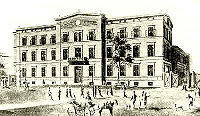 The Anhalter Bahnhof was the Berlin terminus of a line
The Anhalter Bahnhof was the Berlin terminus of a line
begun on 15 April 1839, opened on 1 July 1841 as far as Jüterbog
(the inaugural train being hauled by the very first Borsig locomotive), and extended to Dessau
, Köthen and beyond at later dates. Passing through the historical state of Anhalt
, it became known as the "Anhalt line" and this in turn gave the Berlin terminus its name. It quickly developed into a network that carried train services to and from Leipzig
, Frankfurt am Main and Munich
. Like the nearby Potsdamer Bahnhof
, the Anhalter Bahnhof started out as a fairly modest affair (behind an imposing administration block, the platform area was a mere 15 m wide), but both would go on to much bigger and better things in later years to cope with growing traffic, the Anhalter Bahnhof destined to be Berlin's biggest and finest station.
The front facade faced Askanischer Platz, which was basically a widened section of a street that at that time was known as Hirschelstraße (later Königgrätzer Straße, Stresemannstraße, Saarlandstraße and today back again to Stresemannstraße), then a fairly ramshackle thoroughfare linking Askanischer Platz with Potsdamer Platz (and the Potsdamer Bahnhof), and with Berlin's old customs or excise wall
running down its centre. At the time of the Anhalter Bahnhof's construction there was no opening in the customs wall at this location, and so one was clearly needed so that travellers could get from city to station and vice versa. And so the Anhalter Gate was created in 1839-40, and bore a strong resemblance to architect Karl Friedrich Schinkel
's Potsdam Gate up the road. A new thoroughfare, Anhalter Straße, led from the gate into the city. The Anhalter Gate was one of four extra ones provided in the years after the customs wall's original erection, increasing the total number of gates around the city from 14 to 18. The customs wall eventually became redundant and was demolished in 1866-67, which allowed Hirschelstraße (newly renamed Königgrätzer Straße), to be developed into a proper street for the first time.
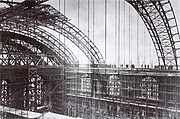 In 1872, architect Franz Heinrich Schwechten
In 1872, architect Franz Heinrich Schwechten
(1841-1924) designed the vast new station that would also be the biggest in Germany and at the time the biggest in Continental Europe, though it was later surpassed. A temporary station was opened in 1874; the old one was demolished in 1875 and the new one begun in 1876. On 15 June 1880, the new terminus was opened by Kaiser Wilhelm I
and Chancellor
Otto von Bismarck
. The new facade was 101 m across and embellished with zinc sculptures titled Day and Night by Ludwig Brunow
(1843-1913), positioned on either side of the clock above the main entrance. Emil Hundrieser (1846-1911) was responsible for a sculpture on the very top of the facade called The International Traffic. Inside the building was a lavish and spacious booking hall with separate waiting rooms and facilities for no fewer than four classes of ticket holders. A separate entrance and reception area were provided for visiting royalty, and these saw frequent use. Behind all this, the huge iron and glass train-shed roof by writer and engineer Heinrich Seidel
(1842-1906) measured 171 m long by 62 m wide (covering 10,600 m², under which 40,000 people could stand), and rose to 34 m in height along its centre line. The Anhalter Güterbahnhof (goods station
), also opened, south of the Landwehr Canal on the same date as the passenger station.
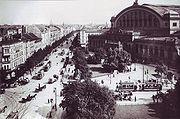 Initially the rebuilt terminus was still handling train services mainly to and from Leipzig, Frankfurt am Main and Munich, over the old Anhalter route. However, two years later it inherited a whole new range of services with the closure of the Dresdner Bahnhof. This terminus had opened on 17 June 1875, with trains to Dresden
Initially the rebuilt terminus was still handling train services mainly to and from Leipzig, Frankfurt am Main and Munich, over the old Anhalter route. However, two years later it inherited a whole new range of services with the closure of the Dresdner Bahnhof. This terminus had opened on 17 June 1875, with trains to Dresden
(over the so-called "Dresdener line"), Prague
and Vienna
, but was small and inconveniently sited some distance from the centre of the city, south of the Landwehr Canal. The Anhalter Bahnhof was more than capable of handling these services as well, and so on 15 October 1882 they were switched, and the Dresdner Bahnhof closed (it actually still exists, next to the present Gleisdreieck U-Bahn
station, having for many years served as part of a major mail-handling facility, itself since closed, called the Postbahnhof). This move was the key to establishing the Anhalter Bahnhof's ultimate importance, as the terminus became Berlin’s “Gateway to the South,” with services via Dresden not only to Prague and Vienna, but to places as far away as Rome
, Naples
and Athens
. By 1930, trains left its six platforms every three to five minutes, carrying an average of 44,000 people daily (around 16 million a year, compared with barely 49,000 at Berlin Tempelhof Airport). Though still less busy than the Potsdamer Bahnhof up the road, the Anhalter Bahnhof was superior in its sheer scale, and in the opulence of its train services. Also by this time, the station was connected directly with the hotel which faced it across Askanischer Platz - the Hotel Excelsior
, Europe's largest - by means of a tunnel, believed to be the longest of its kind in the world at 100 m, constructed in 1927-1928. There were even five underground shops down there.
to Yorckstrasse, via Potsdamer Platz and Anhalter Bahnhof had first been mooted in 1914, but it was not planned in detail until 1928, and then approval had to wait until 1933. Begun in 1934, it was plagued with disasters. Determination to have it finished in time for the Berlin Olympic Games
in 1936 meant vital safety measures were ignored: on 20 August 1935, a tunnel collapse just south of the Brandenburg Gate
buried 23 workmen of whom only four survived; then on 28 December 1936, a fire near the Potsdamer Platz station destroyed vital equipment. The line was not ready for the Berlin Olympics; in fact it was another three years before it first saw public use. In spite of all the setbacks, it was opened from Unter den Linden down to Potsdamer Platz on 15 April 1939, extended to Anhalter Bahnhof on 9 October, and then to Yorckstrasse, to complete the link, on 6 November. At Anhalter Bahnhof S-Bahn station a direct access route to the mainline terminus above was provided from 19 December 1940.
At the S-Bahn station four platforms were provided and all were used, although just two were planned to suffice: the other two were intended originally to be utilised by another new line, which was to branch off eastwards and run under the city to Görlitzer Bahnhof. A connection from Potsdamer Platz was also to be made. Although construction of some tunnel sections went ahead (and these still exist though inaccessible to the public), the line was never opened.
, and yet even if the war had not occurred, major changes would still have taken place. Under Nazi
dictator
Adolf Hitler
's grand plan to transform Berlin into the Welthauptstadt (World Capital) Germania
, to be realised by Albert Speer
, the building would have ceased to be a railway terminus. The new North-South Axis
, the linchpin of the plan, would have severed its approach tracks, leaving the terminus stranded on the wrong side of it. All trains arriving in Berlin would instead have run into either of two vast new stations located on the Ringbahn to the north and south of the centre, to be known as Nordbahnhof (North Station) and Südbahnhof (South Station), located at Wedding
and Südkreuz
respectively, while in Speer's plan the former Anhalter Bahnhof was earmarked to become a public swimming pool. In the end, things took a different course.
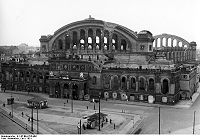 During World War II the Anhalter Bahnhof was one of three stations used to deport some 55,000 Berlin Jews
During World War II the Anhalter Bahnhof was one of three stations used to deport some 55,000 Berlin Jews
between 1941 and 1945, about a third of the city's entire Jewish population (as of 1933). From the Anhalter alone 9,600 left, in groups of 50 to 100 at a time using 116 trains. In contrast to other deportations using freight wagons, here the Jews were taken away in ordinary passenger coaches which were coupled up to regular trains departing according to the normal timetable. All deportations went to Theresienstadt
in Nazi-occupied Czechoslovakia
, and from there to the death camps.
Right up to the very last weeks of the war, transports of Jews from the Anhalter Bahnhof did not cease. The last one, on 27 March 1945, took place at a time when Germany's defeat was already inevitable. 42 Jews, who had until then been considered 'protected', were sent under guard to Theresienstadt Ghetto. The reason for this excess zeal was Adolf Eichmann
's desire to appear busy so that he would not be sent from Berlin to the front.
Meanwhile, during World War II the Anhalter Bahnhof, like most of Berlin, was devastated by British and American bombs and Soviet
artillery shells. A massive bombing raid on the night of 23 November 1943 badly affected the station, and caused so much damage to rail infrastructure further out that long-distance trains could no longer run, just a few local services. Two further major raids on 3 February and 26 February 1945 left the terminus with large sections of its roof missing, the rest unsafe and tottering, and no trains running at all. Many sections of the S-Bahn as well as the U-Bahn were also closed during the war due to enemy action, and the section through Anhalter Bahnhof was no exception.
The S-Bahn North-South Link, less than six years old, became the setting for one of the most contentious episodes of the final Battle of Berlin
, in late April and early May 1945. With Hitler already dead, the remaining Nazi leaders resorted to increasingly desperate measures to slow the Soviet advance, whatever the consequences for their own citizens. Fearful that the Soviets might try to storm the centre of Berlin by coming through the underground rail tunnels, on 2 May the Nazi leaders ordered SS
troops to blow up the bulkheads where the North-South Link passed beneath the Landwehrkanal. Altogether up to 26 km of tunnels and many stations were flooded by this action, most of which had been used as public shelters and also to house military wounded in hospital trains in underground sidings. No one knows how many people were drowned as figures are so diverse and unreliable. According to Soviet propaganda up to 15,000 may have lost their lives, but a more likely figure is two or three hundred.
A fragmentary train service resumed along the North-South Link on 2 June 1946 once massive repairs were well advanced (water had to be pumped out at the beginning). Full services recommenced on 16 November 1947, although repairs were not complete until May 1948. The services were extended further in 1951. Another interruption of services was caused by the uprising of 1953 in East Germany
, no trains running between 17 June, the day of the uprising, and 9 July. Meanwhile, above ground, American servicemen had dismantled the surviving sections of the Anhalter Bahnhof's roof in March 1948, and a limited train service had begun operating again in August, with a few trains running out into the Saxony-Anhalt
and Brandenburg
regions, but it was not to last. The station's final demise was caused by the rapid collapse of relations between the Allied Occupying Powers which controlled Berlin and Germany as a whole. The Anhalter Bahnhof was served by trains arriving from places in Soviet-controlled East Germany, but the terminus was in West Berlin
. An uncomfortable situation to start with, it eventually became a thorn in the Soviets’ side, and so on 17 May 1952, they switched all remaining trains to a station in their Eastern Sector, the Ostbahnhof
, and the Anhalter Bahnhof was closed for good, although apparently not before detailed plans and an architect's model had been produced for a vast modern terminus on the site.
After lying derelict for more than eight years, apparently with some rusting tracks and signals still in situ, demolition was begun on 25 August 1960 and completed by 27 August. There was a considerable public outcry, but according to legend someone had put in a good offer for the bricks. The terminus did not vanish entirely, however, as the centre portion of the facade was allowed to remain standing.
was erected on 13 August 1961, it had a profound effect on rail services in and around the city, and on the S-Bahn and U-Bahn in particular. Essentially both were divided into two systems, with lines being physically severed where they crossed the border between East Berlin
and West Berlin. In most cases trains on either side would simply run as far as the last stop before the border and then reverse back. The S-Bahn North-South Link saw a more bizarre - though not unique - state of affairs. This line, plus two U-Bahn lines elsewhere in the city, suffered from a quirk of geography in that they briefly passed through East German territory en route from one part of West Berlin to another. This gave rise to the infamous "Geisterbahnhöfe" (ghost station
s), those unfortunate ones on the eastern side that were sealed off from the outside world and which trains ran straight through without stopping. (One exception was the station Bahnhof Friedrichstraße, where passengers could change trains to the western part of the East-West-S-Bahn and one line of the U-Bahn (today U6). This station also served as a border checkpoint for people entering East Berlin.) Trains would generally slow down, however, affording passengers the strange sight of dusty, dimly lit platforms patrolled by armed guards, there to prevent any East Berliners from trying to escape to the West by train. At the points where the lines passed directly beneath the actual border, concrete "collars" were constructed within the tunnels with just the minimum clearance for trains, to prevent people clinging to the sides or roof of the coaches. Anhalter Bahnhof station itself remained open; being in West Berlin, it was the last stop for northbound trains before they entered the "restricted section", and the first stop for southbound trains after they had left the section. However, of its four platforms just two (sometimes only one) saw regular use, and the station appeared to receive only a minimum of cleaning and maintenance.
After the fall of the Wall on 9 November 1989, Anhalter Bahnhof S-Bahn station and all the ghost stations underwent a major refurbishment before being re-opened on 1 March 1992.
 Today the S-Bahn station remains the only one open at the location, and still defiantly called "Anhalter Bahnhof" although it is over half a century since the great terminus aboveground closed. As for the terminus itself, today the centre portion of the facade still looks out over Askanischer Platz, having been restored several times since the demolition of the rest of the building. At the top, Ludwig Brunow's Day and Night sculptures, somewhat the worse for wear, still sat on either side of the now empty clock space until the most recent restoration of the structure in 2003-2004, but to avoid further corrosion they have now been replaced by copies (the originals can be seen in the German Museum of Technology
Today the S-Bahn station remains the only one open at the location, and still defiantly called "Anhalter Bahnhof" although it is over half a century since the great terminus aboveground closed. As for the terminus itself, today the centre portion of the facade still looks out over Askanischer Platz, having been restored several times since the demolition of the rest of the building. At the top, Ludwig Brunow's Day and Night sculptures, somewhat the worse for wear, still sat on either side of the now empty clock space until the most recent restoration of the structure in 2003-2004, but to avoid further corrosion they have now been replaced by copies (the originals can be seen in the German Museum of Technology
, close by on the south bank of the Landwehr Canal). The photograph on the right shows the facade remnant in 2005. The oddly-shaped white building faintly visible in the distance on the right is the Tempodrom, a major new concert and event venue.
Close by stands a memorial display board honouring the Berlin Jews taken from here and elsewhere to their deaths by the Nazis during World War II.
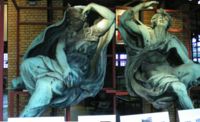 The original "Day and Night" sculptures from the facade, photographed in 2003 in their new home, the German Museum of Technology. Day is on the right, gazing into the distance, while Night, on the left, is looking away.
The original "Day and Night" sculptures from the facade, photographed in 2003 in their new home, the German Museum of Technology. Day is on the right, gazing into the distance, while Night, on the left, is looking away.
 This view shows the rear of the facade remnant in 2005. In the left background is Europahaus
This view shows the rear of the facade remnant in 2005. In the left background is Europahaus
, an office block dating from the early 1930s, while in the right background is the 18-storey Excelsiorhaus, on the site of the former hotel. It is not known whether the underground tunnel that once linked the station with the hotel still exists. In the foreground is a large new synthetic playing surface for sports where the train shed once stood. Immediately south, directly behind the photographer, is the Tempodrom.
The Tempodrom, a major new concert and event venue opened on 8 December 2001, extends across the site of the terminus just south of the train shed's former location. Its innovative futuristic roof rises to a height of 37.5 m.
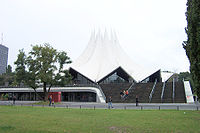
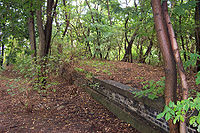 Further south still, extending down to the Landwehr Canal, is an area of woodland, recently tidied up and new paths laid, but amongst the trees and undergrowth, several crumbling sections of platforms are still clearly visible.
Further south still, extending down to the Landwehr Canal, is an area of woodland, recently tidied up and new paths laid, but amongst the trees and undergrowth, several crumbling sections of platforms are still clearly visible.
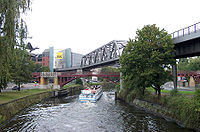 This location appeared on many picture postcards in the early years of the 20th century, and in some ways it has not significantly changed since then. The red-painted bridge side-on to the camera is a recent construction for pedestrians and cyclists, approximating in appearance the railway bridge which once crossed at the same spot. The main arch was once the centre span of three of a much older structure located elsewhere in the city - the Marschallbrücke, built by Eduard Albert Paul Gottheiner in 1881-82, which carried Luisenstraße over the River Spree
This location appeared on many picture postcards in the early years of the 20th century, and in some ways it has not significantly changed since then. The red-painted bridge side-on to the camera is a recent construction for pedestrians and cyclists, approximating in appearance the railway bridge which once crossed at the same spot. The main arch was once the centre span of three of a much older structure located elsewhere in the city - the Marschallbrücke, built by Eduard Albert Paul Gottheiner in 1881-82, which carried Luisenstraße over the River Spree
just to the east of the Reichstag
. Concerns about its condition, coupled with the need to provide greater clearance for vessels on the river, brought about the replacement of the centre and south spans with one long new span in 1997-99, after which the old centre span was re-erected here as shown, as part of this new bridge designed by Benedict Toon and opened in February 2001. Just beyond it is where the S-Bahn North-South Link runs beneath the canal, and it was here that SS troops blew up the bulkheads in the last days of World War 2, deliberately flooding the tunnel in the hope of slowing the Soviet advance. The Anhalter Bahnhof stood out of the picture to the right (north).
The buildings in the left background, on the south bank of the canal, house the German Museum of Technology. The other bridge, the higher one crossing the canal at a sharp angle, carries a section of U-Bahn line between Gleisdreieck and Möckernbrücke stations. Out of the picture to the left are surviving parts of the Anhalter Güterbahnhof (Goods Station).
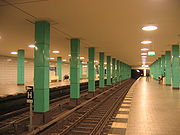

 Hand in hand with the passenger terminus, the goods station had also been rebuilt at the same time (and was opened on the same day). Also the work of Franz Heinrich Schwechten, it was located on the south bank of the Landwehr Canal immediately to the east of the parallel passenger lines. This artistic representation is Schwechten's own front elevation, showing the twin administration blocks linked by an attractive bridge structure, with three arches through which road vehicles passed into the so-called "ladestrasse" (loading road), 20 m wide. On either side were covered goods-handling areas some 210 m in length, with the railway sidings on the other side, to enable efficient movement of goods from railway wagons to road vehicles or vice versa.
Hand in hand with the passenger terminus, the goods station had also been rebuilt at the same time (and was opened on the same day). Also the work of Franz Heinrich Schwechten, it was located on the south bank of the Landwehr Canal immediately to the east of the parallel passenger lines. This artistic representation is Schwechten's own front elevation, showing the twin administration blocks linked by an attractive bridge structure, with three arches through which road vehicles passed into the so-called "ladestrasse" (loading road), 20 m wide. On either side were covered goods-handling areas some 210 m in length, with the railway sidings on the other side, to enable efficient movement of goods from railway wagons to road vehicles or vice versa.
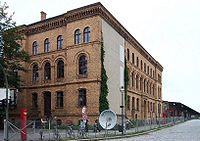 Today the eastern administration block (on the left in the 1874 elevation) is the only one still standing, now restored and today the home of 'Spectrum', the Berlin Science Centre, another part of the German Museum of Technology. Its western twin was badly damaged in World War 2 and was demolished in 1959, the bridge structure following in 1963; the grey rendered area on the side of the building in this picture marks the bridge's erstwhile location. Down the former loading road on the right, the covered goods-handling area is now used mainly by a variety of small industrial concerns. Further down again is a large overgrown area of almost total desolation. Things are however looking much brighter at the adjacent Anhalter locomotive depot to the west, sandwiched between the Anhalter Güterbahnhof and the former Dresdner Bahnhof. After decades of dereliction its buildings have been restored and also incorporated into the German Museum of Technology.
Today the eastern administration block (on the left in the 1874 elevation) is the only one still standing, now restored and today the home of 'Spectrum', the Berlin Science Centre, another part of the German Museum of Technology. Its western twin was badly damaged in World War 2 and was demolished in 1959, the bridge structure following in 1963; the grey rendered area on the side of the building in this picture marks the bridge's erstwhile location. Down the former loading road on the right, the covered goods-handling area is now used mainly by a variety of small industrial concerns. Further down again is a large overgrown area of almost total desolation. Things are however looking much brighter at the adjacent Anhalter locomotive depot to the west, sandwiched between the Anhalter Güterbahnhof and the former Dresdner Bahnhof. After decades of dereliction its buildings have been restored and also incorporated into the German Museum of Technology.
Train station
A train station, also called a railroad station or railway station and often shortened to just station,"Station" is commonly understood to mean "train station" unless otherwise qualified. This is evident from dictionary entries e.g...
in Berlin
Berlin
Berlin is the capital city of Germany and is one of the 16 states of Germany. With a population of 3.45 million people, Berlin is Germany's largest city. It is the second most populous city proper and the seventh most populous urban area in the European Union...
, Germany, approximately 600 metres (0.5 mi) southeast of Potsdamer Platz
Potsdamer Platz
Potsdamer Platz is an important public square and traffic intersection in the centre of Berlin, Germany, lying about one kilometre south of the Brandenburg Gate and the Reichstag , and close to the southeast corner of the Tiergarten park...
. Although the station was closed in 1952, the name lives on in the Berlin S-Bahn
Berlin S-Bahn
The Berlin S-Bahn is a rapid transit system in and around Berlin, the capital city of Germany. It consists of 15 lines and is integrated with the mostly underground U-Bahn to form the backbone of Berlin's rapid transport system...
station of the same name.
Early days

Anhalt Railway
The Anhalt railway , most commonly referred to as the Berlin-Halle railway , is a twin-track, electrified main line found in the German city-state of Berlin, and the states of Brandenburg and Sachsen-Anhalt...
begun on 15 April 1839, opened on 1 July 1841 as far as Jüterbog
Jüterbog
Jüterbog is a historic town in north-eastern Germany, located in the Teltow-Fläming district of Brandenburg. It is located on the Nuthe river at the northern slope of the Fläming hill range, about southwest of Berlin.-History:...
(the inaugural train being hauled by the very first Borsig locomotive), and extended to Dessau
Dessau
Dessau is a town in Germany on the junction of the rivers Mulde and Elbe, in the Bundesland of Saxony-Anhalt. Since 1 July 2007, it is part of the merged town Dessau-Roßlau. Population of Dessau proper: 77,973 .-Geography:...
, Köthen and beyond at later dates. Passing through the historical state of Anhalt
Anhalt
Anhalt was a sovereign county in Germany, located between the Harz Mountains and the river Elbe in Middle Germany. It now forms part of the state of Saxony-Anhalt.- Dukes of Anhalt :...
, it became known as the "Anhalt line" and this in turn gave the Berlin terminus its name. It quickly developed into a network that carried train services to and from Leipzig
Leipzig
Leipzig Leipzig has always been a trade city, situated during the time of the Holy Roman Empire at the intersection of the Via Regia and Via Imperii, two important trade routes. At one time, Leipzig was one of the major European centres of learning and culture in fields such as music and publishing...
, Frankfurt am Main and Munich
Munich
Munich The city's motto is "" . Before 2006, it was "Weltstadt mit Herz" . Its native name, , is derived from the Old High German Munichen, meaning "by the monks' place". The city's name derives from the monks of the Benedictine order who founded the city; hence the monk depicted on the city's coat...
. Like the nearby Potsdamer Bahnhof
Berlin Potsdamer Bahnhof
The Potsdamer Bahnhof is a former railway terminus in Berlin, Germany. It was located at Potsdamer Platz, about 1 km south of the Brandenburg Gate, and kick-started the transformation of Potsdamer Platz from an area of quiet villas near the south-east corner of the Tiergarten into the bustling...
, the Anhalter Bahnhof started out as a fairly modest affair (behind an imposing administration block, the platform area was a mere 15 m wide), but both would go on to much bigger and better things in later years to cope with growing traffic, the Anhalter Bahnhof destined to be Berlin's biggest and finest station.
The front facade faced Askanischer Platz, which was basically a widened section of a street that at that time was known as Hirschelstraße (later Königgrätzer Straße, Stresemannstraße, Saarlandstraße and today back again to Stresemannstraße), then a fairly ramshackle thoroughfare linking Askanischer Platz with Potsdamer Platz (and the Potsdamer Bahnhof), and with Berlin's old customs or excise wall
Berlin Customs Wall
The Berlin Customs Wall was a ring wall around the historic city of Berlin; the wall itself had no defence function but was used to facilitate the levying of taxes on the import and export of goods which was the primary income of many cities at the time.- History :The wall was erected...
running down its centre. At the time of the Anhalter Bahnhof's construction there was no opening in the customs wall at this location, and so one was clearly needed so that travellers could get from city to station and vice versa. And so the Anhalter Gate was created in 1839-40, and bore a strong resemblance to architect Karl Friedrich Schinkel
Karl Friedrich Schinkel
Karl Friedrich Schinkel was a Prussian architect, city planner, and painter who also designed furniture and stage sets. Schinkel was one of the most prominent architects of Germany and designed both neoclassical and neogothic buildings.-Biography:Schinkel was born in Neuruppin, Margraviate of...
's Potsdam Gate up the road. A new thoroughfare, Anhalter Straße, led from the gate into the city. The Anhalter Gate was one of four extra ones provided in the years after the customs wall's original erection, increasing the total number of gates around the city from 14 to 18. The customs wall eventually became redundant and was demolished in 1866-67, which allowed Hirschelstraße (newly renamed Königgrätzer Straße), to be developed into a proper street for the first time.
Extension

Franz Heinrich Schwechten
Franz Heinrich Schwechten was one of the most famous German architects of his time, and has contributed to the development of the historicist architecture....
(1841-1924) designed the vast new station that would also be the biggest in Germany and at the time the biggest in Continental Europe, though it was later surpassed. A temporary station was opened in 1874; the old one was demolished in 1875 and the new one begun in 1876. On 15 June 1880, the new terminus was opened by Kaiser Wilhelm I
William I, German Emperor
William I, also known as Wilhelm I , of the House of Hohenzollern was the King of Prussia and the first German Emperor .Under the leadership of William and his Chancellor Otto von Bismarck, Prussia achieved the unification of Germany and the...
and Chancellor
Chancellor
Chancellor is the title of various official positions in the governments of many nations. The original chancellors were the Cancellarii of Roman courts of justice—ushers who sat at the cancelli or lattice work screens of a basilica or law court, which separated the judge and counsel from the...
Otto von Bismarck
Otto von Bismarck
Otto Eduard Leopold, Prince of Bismarck, Duke of Lauenburg , simply known as Otto von Bismarck, was a Prussian-German statesman whose actions unified Germany, made it a major player in world affairs, and created a balance of power that kept Europe at peace after 1871.As Minister President of...
. The new facade was 101 m across and embellished with zinc sculptures titled Day and Night by Ludwig Brunow
Ludwig Brunow
Ludwig Brunow was a German sculptor.A more comprehensive article is available in German from the German Wikipedia...
(1843-1913), positioned on either side of the clock above the main entrance. Emil Hundrieser (1846-1911) was responsible for a sculpture on the very top of the facade called The International Traffic. Inside the building was a lavish and spacious booking hall with separate waiting rooms and facilities for no fewer than four classes of ticket holders. A separate entrance and reception area were provided for visiting royalty, and these saw frequent use. Behind all this, the huge iron and glass train-shed roof by writer and engineer Heinrich Seidel
Heinrich Seidel
Heinrich Friedrich Wilhelm Seidel was a German engineer, poet and writer.-Life:...
(1842-1906) measured 171 m long by 62 m wide (covering 10,600 m², under which 40,000 people could stand), and rose to 34 m in height along its centre line. The Anhalter Güterbahnhof (goods station
Goods station
A goods station is, in the widest sense, a railway station which is exclusively or predominantly where goods of any description are loaded or unloaded from ships or road vehicles and/or where goods wagons are transferred to local sidings.A station where goods are not specifically received or...
), also opened, south of the Landwehr Canal on the same date as the passenger station.
“Gateway to the South”

Dresden
Dresden is the capital city of the Free State of Saxony in Germany. It is situated in a valley on the River Elbe, near the Czech border. The Dresden conurbation is part of the Saxon Triangle metropolitan area....
(over the so-called "Dresdener line"), Prague
Prague
Prague is the capital and largest city of the Czech Republic. Situated in the north-west of the country on the Vltava river, the city is home to about 1.3 million people, while its metropolitan area is estimated to have a population of over 2.3 million...
and Vienna
Vienna
Vienna is the capital and largest city of the Republic of Austria and one of the nine states of Austria. Vienna is Austria's primary city, with a population of about 1.723 million , and is by far the largest city in Austria, as well as its cultural, economic, and political centre...
, but was small and inconveniently sited some distance from the centre of the city, south of the Landwehr Canal. The Anhalter Bahnhof was more than capable of handling these services as well, and so on 15 October 1882 they were switched, and the Dresdner Bahnhof closed (it actually still exists, next to the present Gleisdreieck U-Bahn
Berlin U-Bahn
The Berlin is a rapid transit railway in Berlin, the capital city of Germany, and is a major part of the public transport system of that city. Opened in 1902, the serves 173 stations spread across ten lines, with a total track length of , about 80% of which is underground...
station, having for many years served as part of a major mail-handling facility, itself since closed, called the Postbahnhof). This move was the key to establishing the Anhalter Bahnhof's ultimate importance, as the terminus became Berlin’s “Gateway to the South,” with services via Dresden not only to Prague and Vienna, but to places as far away as Rome
Rome
Rome is the capital of Italy and the country's largest and most populated city and comune, with over 2.7 million residents in . The city is located in the central-western portion of the Italian Peninsula, on the Tiber River within the Lazio region of Italy.Rome's history spans two and a half...
, Naples
Naples
Naples is a city in Southern Italy, situated on the country's west coast by the Gulf of Naples. Lying between two notable volcanic regions, Mount Vesuvius and the Phlegraean Fields, it is the capital of the region of Campania and of the province of Naples...
and Athens
Athens
Athens , is the capital and largest city of Greece. Athens dominates the Attica region and is one of the world's oldest cities, as its recorded history spans around 3,400 years. Classical Athens was a powerful city-state...
. By 1930, trains left its six platforms every three to five minutes, carrying an average of 44,000 people daily (around 16 million a year, compared with barely 49,000 at Berlin Tempelhof Airport). Though still less busy than the Potsdamer Bahnhof up the road, the Anhalter Bahnhof was superior in its sheer scale, and in the opulence of its train services. Also by this time, the station was connected directly with the hotel which faced it across Askanischer Platz - the Hotel Excelsior
Hotel Excelsior
Hotel Excelsior occupied number 112/113, Königgrätzer Straße on Askanischer Platz in the Berlin district of Kreuzberg...
, Europe's largest - by means of a tunnel, believed to be the longest of its kind in the world at 100 m, constructed in 1927-1928. There were even five underground shops down there.
The S-Bahn
In 1939 the S-Bahn or Stadtbahn (City Railway) arrived. The idea for a North-South Link rapid transit rail line from Unter den LindenUnter den Linden
Unter den Linden is a boulevard in the Mitte district of Berlin, the capital of Germany. It is named for its linden trees that line the grassed pedestrian mall between two carriageways....
to Yorckstrasse, via Potsdamer Platz and Anhalter Bahnhof had first been mooted in 1914, but it was not planned in detail until 1928, and then approval had to wait until 1933. Begun in 1934, it was plagued with disasters. Determination to have it finished in time for the Berlin Olympic Games
1936 Summer Olympics
The 1936 Summer Olympics, officially known as the Games of the XI Olympiad, was an international multi-sport event which was held in 1936 in Berlin, Germany. Berlin won the bid to host the Games over Barcelona, Spain on April 26, 1931, at the 29th IOC Session in Barcelona...
in 1936 meant vital safety measures were ignored: on 20 August 1935, a tunnel collapse just south of the Brandenburg Gate
Brandenburg Gate
The Brandenburg Gate is a former city gate and one of the most well-known landmarks of Berlin and Germany. It is located west of the city centre at the junction of Unter den Linden and Ebertstraße, immediately west of the Pariser Platz. It is the only remaining gate of a series through which...
buried 23 workmen of whom only four survived; then on 28 December 1936, a fire near the Potsdamer Platz station destroyed vital equipment. The line was not ready for the Berlin Olympics; in fact it was another three years before it first saw public use. In spite of all the setbacks, it was opened from Unter den Linden down to Potsdamer Platz on 15 April 1939, extended to Anhalter Bahnhof on 9 October, and then to Yorckstrasse, to complete the link, on 6 November. At Anhalter Bahnhof S-Bahn station a direct access route to the mainline terminus above was provided from 19 December 1940.
At the S-Bahn station four platforms were provided and all were used, although just two were planned to suffice: the other two were intended originally to be utilised by another new line, which was to branch off eastwards and run under the city to Görlitzer Bahnhof. A connection from Potsdamer Platz was also to be made. Although construction of some tunnel sections went ahead (and these still exist though inaccessible to the public), the line was never opened.
Plans to turn into a swimming pool
The fate of the Anhalter Bahnhof was determined by World War IIWorld War II
World War II, or the Second World War , was a global conflict lasting from 1939 to 1945, involving most of the world's nations—including all of the great powers—eventually forming two opposing military alliances: the Allies and the Axis...
, and yet even if the war had not occurred, major changes would still have taken place. Under Nazi
Nazism
Nazism, the common short form name of National Socialism was the ideology and practice of the Nazi Party and of Nazi Germany...
dictator
Dictator
A dictator is a ruler who assumes sole and absolute power but without hereditary ascension such as an absolute monarch. When other states call the head of state of a particular state a dictator, that state is called a dictatorship...
Adolf Hitler
Adolf Hitler
Adolf Hitler was an Austrian-born German politician and the leader of the National Socialist German Workers Party , commonly referred to as the Nazi Party). He was Chancellor of Germany from 1933 to 1945, and head of state from 1934 to 1945...
's grand plan to transform Berlin into the Welthauptstadt (World Capital) Germania
Welthauptstadt Germania
Welthauptstadt Germania refers to the projected renewal of the German capital Berlin during the Nazi period, part of Adolf Hitler's vision for the future of Germany after the planned victory in World War II...
, to be realised by Albert Speer
Albert Speer
Albert Speer, born Berthold Konrad Hermann Albert Speer, was a German architect who was, for a part of World War II, Minister of Armaments and War Production for the Third Reich. Speer was Adolf Hitler's chief architect before assuming ministerial office...
, the building would have ceased to be a railway terminus. The new North-South Axis
North-South Axis
The North–South Axis is a tram tunnel in Brussels, Belgium, which crosses the city center from North to South starting at the Brussels-North railway station to the Albert premetro station. The first section of this tunnel was first opened on October 4, 1976 between the Brussels-North railway...
, the linchpin of the plan, would have severed its approach tracks, leaving the terminus stranded on the wrong side of it. All trains arriving in Berlin would instead have run into either of two vast new stations located on the Ringbahn to the north and south of the centre, to be known as Nordbahnhof (North Station) and Südbahnhof (South Station), located at Wedding
Wedding (Berlin)
Wedding is a locality in the borough of Mitte, Berlin, Germany and was a separate borough in the north-western inner city until it was fused with Tiergarten and Mitte in Berlin's 2001 administrative reform...
and Südkreuz
Berlin Südkreuz
Berlin Südkreuz is a railway station in the German capital Berlin. The station was originally opened in 1898 and is an interchange station...
respectively, while in Speer's plan the former Anhalter Bahnhof was earmarked to become a public swimming pool. In the end, things took a different course.
World War II and its aftermath

Jews
The Jews , also known as the Jewish people, are a nation and ethnoreligious group originating in the Israelites or Hebrews of the Ancient Near East. The Jewish ethnicity, nationality, and religion are strongly interrelated, as Judaism is the traditional faith of the Jewish nation...
between 1941 and 1945, about a third of the city's entire Jewish population (as of 1933). From the Anhalter alone 9,600 left, in groups of 50 to 100 at a time using 116 trains. In contrast to other deportations using freight wagons, here the Jews were taken away in ordinary passenger coaches which were coupled up to regular trains departing according to the normal timetable. All deportations went to Theresienstadt
Theresienstadt concentration camp
Theresienstadt concentration camp was a Nazi German ghetto during World War II. It was established by the Gestapo in the fortress and garrison city of Terezín , located in what is now the Czech Republic.-History:The fortress of Terezín was constructed between the years 1780 and 1790 by the orders...
in Nazi-occupied Czechoslovakia
Czechoslovakia
Czechoslovakia or Czecho-Slovakia was a sovereign state in Central Europe which existed from October 1918, when it declared its independence from the Austro-Hungarian Empire, until 1992...
, and from there to the death camps.
Right up to the very last weeks of the war, transports of Jews from the Anhalter Bahnhof did not cease. The last one, on 27 March 1945, took place at a time when Germany's defeat was already inevitable. 42 Jews, who had until then been considered 'protected', were sent under guard to Theresienstadt Ghetto. The reason for this excess zeal was Adolf Eichmann
Adolf Eichmann
Adolf Otto Eichmann was a German Nazi and SS-Obersturmbannführer and one of the major organizers of the Holocaust...
's desire to appear busy so that he would not be sent from Berlin to the front.
Meanwhile, during World War II the Anhalter Bahnhof, like most of Berlin, was devastated by British and American bombs and Soviet
Soviet Union
The Soviet Union , officially the Union of Soviet Socialist Republics , was a constitutionally socialist state that existed in Eurasia between 1922 and 1991....
artillery shells. A massive bombing raid on the night of 23 November 1943 badly affected the station, and caused so much damage to rail infrastructure further out that long-distance trains could no longer run, just a few local services. Two further major raids on 3 February and 26 February 1945 left the terminus with large sections of its roof missing, the rest unsafe and tottering, and no trains running at all. Many sections of the S-Bahn as well as the U-Bahn were also closed during the war due to enemy action, and the section through Anhalter Bahnhof was no exception.
The S-Bahn North-South Link, less than six years old, became the setting for one of the most contentious episodes of the final Battle of Berlin
Battle of Berlin
The Battle of Berlin, designated the Berlin Strategic Offensive Operation by the Soviet Union, was the final major offensive of the European Theatre of World War II....
, in late April and early May 1945. With Hitler already dead, the remaining Nazi leaders resorted to increasingly desperate measures to slow the Soviet advance, whatever the consequences for their own citizens. Fearful that the Soviets might try to storm the centre of Berlin by coming through the underground rail tunnels, on 2 May the Nazi leaders ordered SS
Schutzstaffel
The Schutzstaffel |Sig runes]]) was a major paramilitary organization under Adolf Hitler and the Nazi Party. Built upon the Nazi ideology, the SS under Heinrich Himmler's command was responsible for many of the crimes against humanity during World War II...
troops to blow up the bulkheads where the North-South Link passed beneath the Landwehrkanal. Altogether up to 26 km of tunnels and many stations were flooded by this action, most of which had been used as public shelters and also to house military wounded in hospital trains in underground sidings. No one knows how many people were drowned as figures are so diverse and unreliable. According to Soviet propaganda up to 15,000 may have lost their lives, but a more likely figure is two or three hundred.
A fragmentary train service resumed along the North-South Link on 2 June 1946 once massive repairs were well advanced (water had to be pumped out at the beginning). Full services recommenced on 16 November 1947, although repairs were not complete until May 1948. The services were extended further in 1951. Another interruption of services was caused by the uprising of 1953 in East Germany
Uprising of 1953 in East Germany
The Uprising of 1953 in East Germany started with a strike by East Berlin construction workers on June 16. It turned into a widespread anti-Stalinist uprising against the German Democratic Republic government the next day....
, no trains running between 17 June, the day of the uprising, and 9 July. Meanwhile, above ground, American servicemen had dismantled the surviving sections of the Anhalter Bahnhof's roof in March 1948, and a limited train service had begun operating again in August, with a few trains running out into the Saxony-Anhalt
Saxony-Anhalt
Saxony-Anhalt is a landlocked state of Germany. Its capital is Magdeburg and it is surrounded by the German states of Lower Saxony, Brandenburg, Saxony, and Thuringia.Saxony-Anhalt covers an area of...
and Brandenburg
Brandenburg
Brandenburg is one of the sixteen federal-states of Germany. It lies in the east of the country and is one of the new federal states that were re-created in 1990 upon the reunification of the former West Germany and East Germany. The capital is Potsdam...
regions, but it was not to last. The station's final demise was caused by the rapid collapse of relations between the Allied Occupying Powers which controlled Berlin and Germany as a whole. The Anhalter Bahnhof was served by trains arriving from places in Soviet-controlled East Germany, but the terminus was in West Berlin
West Berlin
West Berlin was a political exclave that existed between 1949 and 1990. It comprised the western regions of Berlin, which were bordered by East Berlin and parts of East Germany. West Berlin consisted of the American, British, and French occupation sectors, which had been established in 1945...
. An uncomfortable situation to start with, it eventually became a thorn in the Soviets’ side, and so on 17 May 1952, they switched all remaining trains to a station in their Eastern Sector, the Ostbahnhof
Berlin Ostbahnhof
Berlin Ostbahnhof is a mainline railway station in Berlin, Germany. It is in Friedrichshain, now part of Friedrichshain-Kreuzberg district, and has undergone several name changes in its history. It was known as Berlin Hauptbahnhof from 1987 to 1998, a name now applied to Berlin's new central station...
, and the Anhalter Bahnhof was closed for good, although apparently not before detailed plans and an architect's model had been produced for a vast modern terminus on the site.
After lying derelict for more than eight years, apparently with some rusting tracks and signals still in situ, demolition was begun on 25 August 1960 and completed by 27 August. There was a considerable public outcry, but according to legend someone had put in a good offer for the bricks. The terminus did not vanish entirely, however, as the centre portion of the facade was allowed to remain standing.
The Berlin Wall
When the Berlin WallBerlin Wall
The Berlin Wall was a barrier constructed by the German Democratic Republic starting on 13 August 1961, that completely cut off West Berlin from surrounding East Germany and from East Berlin...
was erected on 13 August 1961, it had a profound effect on rail services in and around the city, and on the S-Bahn and U-Bahn in particular. Essentially both were divided into two systems, with lines being physically severed where they crossed the border between East Berlin
East Berlin
East Berlin was the name given to the eastern part of Berlin between 1949 and 1990. It consisted of the Soviet sector of Berlin that was established in 1945. The American, British and French sectors became West Berlin, a part strongly associated with West Germany but a free city...
and West Berlin. In most cases trains on either side would simply run as far as the last stop before the border and then reverse back. The S-Bahn North-South Link saw a more bizarre - though not unique - state of affairs. This line, plus two U-Bahn lines elsewhere in the city, suffered from a quirk of geography in that they briefly passed through East German territory en route from one part of West Berlin to another. This gave rise to the infamous "Geisterbahnhöfe" (ghost station
Ghost station
Ghost stations is the usual English translation for the German word Geisterbahnhöfe. This term was used to describe certain stations on Berlin's U-Bahn and S-Bahn metro networks that were closed during the period of Berlin's division during the Cold War...
s), those unfortunate ones on the eastern side that were sealed off from the outside world and which trains ran straight through without stopping. (One exception was the station Bahnhof Friedrichstraße, where passengers could change trains to the western part of the East-West-S-Bahn and one line of the U-Bahn (today U6). This station also served as a border checkpoint for people entering East Berlin.) Trains would generally slow down, however, affording passengers the strange sight of dusty, dimly lit platforms patrolled by armed guards, there to prevent any East Berliners from trying to escape to the West by train. At the points where the lines passed directly beneath the actual border, concrete "collars" were constructed within the tunnels with just the minimum clearance for trains, to prevent people clinging to the sides or roof of the coaches. Anhalter Bahnhof station itself remained open; being in West Berlin, it was the last stop for northbound trains before they entered the "restricted section", and the first stop for southbound trains after they had left the section. However, of its four platforms just two (sometimes only one) saw regular use, and the station appeared to receive only a minimum of cleaning and maintenance.
After the fall of the Wall on 9 November 1989, Anhalter Bahnhof S-Bahn station and all the ghost stations underwent a major refurbishment before being re-opened on 1 March 1992.
The site today

German Museum of Technology (Berlin)
Deutsches Technikmuseum Berlin was founded in 1982 in Berlin, Germany, and exhibits a large collection of historical technical artifacts. The museum's main emphasis is on rail transport, but it also features exhibits of various sorts of industrial technology. Recently, it has opened both maritime...
, close by on the south bank of the Landwehr Canal). The photograph on the right shows the facade remnant in 2005. The oddly-shaped white building faintly visible in the distance on the right is the Tempodrom, a major new concert and event venue.
Close by stands a memorial display board honouring the Berlin Jews taken from here and elsewhere to their deaths by the Nazis during World War II.


Europahaus
Europahaus , is a large high-rise office block in Berlin, Germany, located in the Kreuzberg district on Stresemannstraße, facing the remains of the former Anhalter Bahnhof across Askanischer Platz....
, an office block dating from the early 1930s, while in the right background is the 18-storey Excelsiorhaus, on the site of the former hotel. It is not known whether the underground tunnel that once linked the station with the hotel still exists. In the foreground is a large new synthetic playing surface for sports where the train shed once stood. Immediately south, directly behind the photographer, is the Tempodrom.
The Tempodrom, a major new concert and event venue opened on 8 December 2001, extends across the site of the terminus just south of the train shed's former location. Its innovative futuristic roof rises to a height of 37.5 m.



Spree
The Spree is a river that flows through the Saxony, Brandenburg and Berlin states of Germany, and in the Ústí nad Labem region of the Czech Republic...
just to the east of the Reichstag
Reichstag (building)
The Reichstag building is a historical edifice in Berlin, Germany, constructed to house the Reichstag, parliament of the German Empire. It was opened in 1894 and housed the Reichstag until 1933, when it was severely damaged in a fire. During the Nazi era, the few meetings of members of the...
. Concerns about its condition, coupled with the need to provide greater clearance for vessels on the river, brought about the replacement of the centre and south spans with one long new span in 1997-99, after which the old centre span was re-erected here as shown, as part of this new bridge designed by Benedict Toon and opened in February 2001. Just beyond it is where the S-Bahn North-South Link runs beneath the canal, and it was here that SS troops blew up the bulkheads in the last days of World War 2, deliberately flooding the tunnel in the hope of slowing the Soviet advance. The Anhalter Bahnhof stood out of the picture to the right (north).
The buildings in the left background, on the south bank of the canal, house the German Museum of Technology. The other bridge, the higher one crossing the canal at a sharp angle, carries a section of U-Bahn line between Gleisdreieck and Möckernbrücke stations. Out of the picture to the left are surviving parts of the Anhalter Güterbahnhof (Goods Station).

Anhalter Güterbahnhof (goods station)



Sources
- Rainer Knothe: Anhalter Bahnhof – Entwicklung und Betrieb, 1997, EK-Verlag, ISBN 3882556811
- Helmut Maier: Berlin Anhalter Bahnhof, 1984, Ästhetik und Kommunikation Verlag, ISBN 3882451084
- Alfred Gottwaldt: Berlin – Anhalter Bahnhof, 1986, Alba Verlag, ISBN 3870942266
- Peter Kliem, Klaus Noack: Berlin Anhalter Bahnhof, 1984, Ullstein Verlag, ISBN 3550079648

